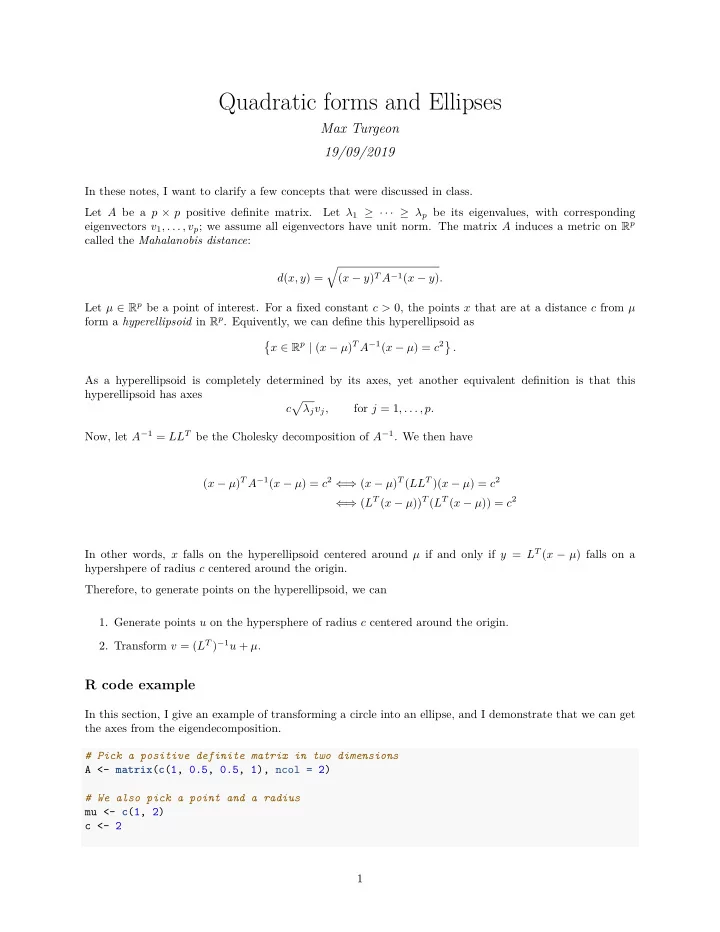

Quadratic forms and Ellipses Max Turgeon 19/09/2019 In these notes, I want to clarify a few concepts that were discussed in class. Let A be a p × p positive definite matrix. Let λ 1 ≥ · · · ≥ λ p be its eigenvalues, with corresponding eigenvectors v 1 , . . . , v p ; we assume all eigenvectors have unit norm. The matrix A induces a metric on R p called the Mahalanobis distance : � ( x − y ) T A − 1 ( x − y ) . d ( x, y ) = Let µ ∈ R p be a point of interest. For a fixed constant c > 0, the points x that are at a distance c from µ form a hyperellipsoid in R p . Equivently, we can define this hyperellipsoid as x ∈ R p | ( x − µ ) T A − 1 ( x − µ ) = c 2 � � . As a hyperellipsoid is completely determined by its axes, yet another equivalent definition is that this hyperellipsoid has axes � for j = 1 , . . . , p. c λ j v j , Now, let A − 1 = LL T be the Cholesky decomposition of A − 1 . We then have ( x − µ ) T A − 1 ( x − µ ) = c 2 ⇐ ⇒ ( x − µ ) T ( LL T )( x − µ ) = c 2 ⇒ ( L T ( x − µ )) T ( L T ( x − µ )) = c 2 ⇐ In other words, x falls on the hyperellipsoid centered around µ if and only if y = L T ( x − µ ) falls on a hypershpere of radius c centered around the origin. Therefore, to generate points on the hyperellipsoid, we can 1. Generate points u on the hypersphere of radius c centered around the origin. 2. Transform v = ( L T ) − 1 u + µ . R code example In this section, I give an example of transforming a circle into an ellipse, and I demonstrate that we can get the axes from the eigendecomposition. # Pick a positive definite matrix in two dimensions A <- matrix ( c (1, 0.5, 0.5, 1), ncol = 2) # We also pick a point and a radius mu <- c (1, 2) c <- 2 1
# First create a circle of radius c theta_vect <- seq (0, 2 * pi, length.out = 100) circle <- c * cbind ( cos (theta_vect), sin (theta_vect)) plot (circle, type = 'l', xlab = "", ylab = "") 2 1 0 −1 −2 −2 −1 0 1 2 # Compute inverse Cholesky transf_mat <- solve ( chol ( solve (A))) # Then turn circle into ellipse ellipse <- circle %*% t (transf_mat) # Then translate ellipse <- t ( apply (ellipse, 1, function (row) row + mu)) plot (ellipse, type = 'l', xlab = "", ylab = "") points (mu[1], mu[2]) 2
4 3 2 1 0 −1 0 1 2 3 # Compute the eigendecomposition decomp <- eigen (A, symmetric = TRUE) first_axis <- c *sqrt (decomp $ value[1]) * decomp $ vectors[,1] second_axis <- c *sqrt (decomp $ value[2]) * decomp $ vectors[,2] # Plot everything together plot (ellipse, type = 'l', xlab = "", ylab = "") points (mu[1], mu[2]) lines (x = c (mu[1], first_axis[1] + mu[1]), y = c (mu[2], first_axis[2] + mu[2])) lines (x = c (mu[1], second_axis[1] + mu[1]), y = c (mu[2], second_axis[2] + mu[2])) 3
4 3 2 1 0 −1 0 1 2 3 You can find an animation of this process (i.e. circle to ellipsis followed by a translation) on the course website: https://www.maxturgeon.ca/f19-stat4690/ellipse.gif 4
Recommend
More recommend